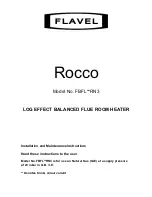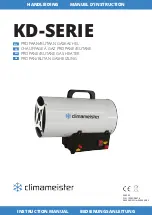
27
Venting continued-
Figure 15 - Typical Horizontal Power Vent System
Vertical Installation
Vertical venting
must be
supported every 5 ft of vertical run and every 3 ft of horizontal run of vent pipe length.
Stress levels in the pipe and fittings can be significantly increased by improper installation. If rigid pipe clamps are used to
hold the pipe in place, or if the pipe cannot move freely through a wall penetration, the pipe may be directly stressed, or
high thermal stresses may be formed when the pipe heats up and expands. Install accordingly to minimize such stresses.
CAUTION
Failure to properly support the vent piping with hangers and clamps may result in
damage to the water heater or venting system.
Follow the following procedure to vent through the roof:
1. Cut the necessary holes through the
roof and ceiling. Cut one 2 3/8 in
(6
cm),
diameter hole (for 2 in
(5.1 cm)
diameter pipe), one 3 1/2 in
(8.9 cm)
diameter hole (for 3 in
(7.6 cm)
diameter pipe) one 4 1/2 in
(11.5 cm)
diameter hole (for 4 in
(10.2 cm)
diameter pipe) or one 6 5/8 in
(16.5
cm)
(for 6 in
(15.2 cm)
diameter pipe).
2. Install the exhaust vent and air intake
plastic pipes as shown in Figure 16.
Make sure that the installation meets
the local codes and/or The National
Fuel Gas Code ANSI Z223.1 (Latest
Edition) or CGA/CAN B149 Installation
Code.
WARNING!
DO NOT USE
2” VENT WITH
100T250/300
MODELS.
Figure 16 - Typical Vertical Power
Vent System Installation
WARNING!
DO NOT USE
2” VENT WITH
100T250/300
MODELS.
Содержание 100T199
Страница 59: ...59 NOTES ...
Страница 60: ...60 NOTES ...
















































